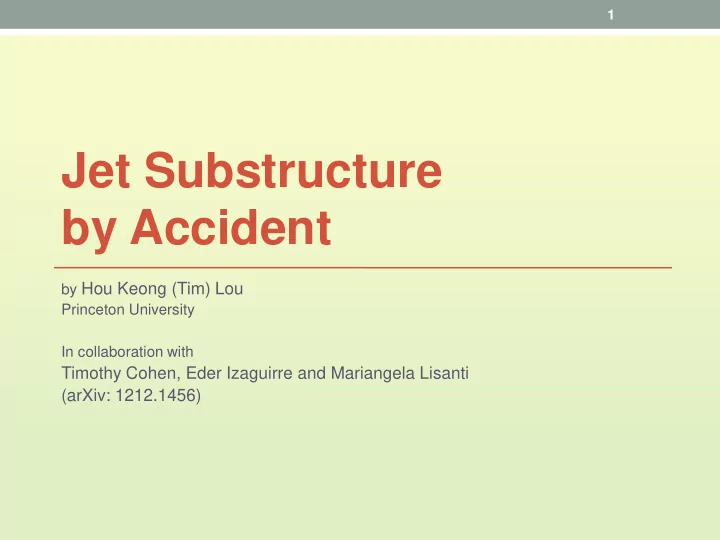

1 Jet Substructure by Accident by Hou Keong (Tim) Lou Princeton University In collaboration with Timothy Cohen, Eder Izaguirre and Mariangela Lisanti (arXiv: 1212.1456)
2 New Physics in Multijets • Natural SUSY → light stops → multitops/multijets • New physics could be hiding in multi-jets • Need robust multijet search techniques
3 Jet Substructure • Boosted particle can decay into collimated final states • Size • Cluster into a single fat-jet • Boosted particles decay → jet substructure • Can we use substructure for non-boosted particles?
4 Accidental Substructure • Substructure without “boost”? • Multiple quarks get clustered together by accident
5 Accidental Substructure • Idea not new: Substructure • Event Shapes • N -jettiness (Stewart et. al.) Accidental N -jettiness Substructure? • Multi-jet = multiple interpretations Jet counting • Optimization: Multiplicity • Background control • Signal discrimination
6 Multijet challenges • Modeling ≳ 8 jets challenging: • matrix elements N jet ? • matching • Need data-driven method • Jet N +1 / Jet N = ? (E. Gerwick et. al. arXiv:1208.3676) • Alternatives?
7 Fat-Jets • Factorize phase space • Fix 4 Fat-jets • Anomalies in substructures • Data-Driven background • QCD = MC ⊗ Data Driven • Kinematics: MC • Substructure: Data Driven • P 4-jets = P jet1 • P jet2 • P jet3 • P jet3
8 Case Study • SUSY pair production • or decay through RPV term • No (suppressed) Missing 𝐹 𝑈
9 Monte Carlo Modeling • QCD • Sherpa event generation and showering • 𝑞 𝑞 → up to 6 partons • tree-level matrix elements, matched • 400 million events • Signal • Madgraph/Pythia for event generation • Pythia for parton showering • 50 thousand events/mass point • Analysis • Fastjet-3 for jet clustering • Simplified detector mockup
10 Skinny-Jets at colliders Detector coordinates • Jet clustering: anti- 𝑙 𝑈 algorithm • Small radius (R=0.4)
11 Skinny-Jets at colliders Detector coordinates • Jet clustering: anti- 𝑙 𝑈 algorithm • Small radius (R=0.4)
12 Fat-Jets at colliders Detector coordinates • Jet clustering: anti- 𝑙 𝑈 algorithm • Big radius (R=1.2)
13 Accidental Substructure • N -subjettiness, 𝜐 𝑛𝑜 (J. Thaler et al.) • Event-subjettiness • 𝑈 43 ≪ 1 for signal Event with small 𝑈 43
14 • Demand 4 jets > 50 GeV: • 1 st jet > 100 GeV • trimmed with 𝑆 𝑡𝑣𝑐 = 0.3, 𝑔 𝑑𝑣𝑢 = 0.05 • Jet mass: • QCD • Multijet new physics • • Define Total Jet Mass (Hook et. al.) • M J > 500 keep
15 • Event-subjettiness: T 43 < 0.6 keep
16 • Event-subjettiness ( T 43 < 0.6) improves limits by 350 GeV
17 • Same cut as before except T 21 < 0.2 • Competitive with ATLAS’s skinny -jet result (in green) • Our method is viable and competitive
18 Conclusion • New Physics could be hiding in Multijets • Need for robust data-driven technique • Accidental Substructure in Multijet • Accidental Substructure is competitive with simple jet counting
19 Future directions • Data-driven background • Other substructure variables • Energy correlation? (Larkoski et. al.) • Multivariate optimization • Detector effects, underlying events and pileup
20 Thank You! Questions?
21 Back up Slides
22 𝜐 43 Plots
23 Data-Driven Substructure • Build template densities 𝜍(𝜐 21 , 𝑞 𝑈 ) from dijet sample • Obtain 𝑞 𝑈,𝑘 from MC, and 𝜐 21 from template densities assuming: • 𝜍 𝜐 21,1 , 𝜐 21,2 , 𝜐 21,3 , 𝜐 21,4 = 𝜍(𝜐 21,1 ) ∙ 𝜍(𝜐 21,2 ) ∙ 𝜍(𝜐 21,3 ) ∙ 𝜍(𝜐 21,4 ) • If correlation between jets are small, we may be able to apply a perturbative expansion • Potential problems: • Correlations may be large • How to parameterize quark vs. gluon mixture? • How to quantify systematics?
24 Exclusion statistics • To compute the excluded cross-section: For a given set of cuts, and a given luminosity we obtain B 1. and the sign cut efficiency 𝜗cut from MC We compute the probability of observing at most B events given 2. a background distribution around 𝜈 events To take systematic uncertainty ( 𝜗sys = 20% ) into account, we 3. take the test statistics to be For a given B , we solve for S exc for p-value=0.05 (95% exclusion) 4.
25 Jet clustering • Sequential clustering: • m esons and baryons are clustered into “ pseudojet ” sequentially • Algoirthm terminates and pseudojets are turned into jets • Controlled by two functions • 𝑒 𝑗𝑘 the pseudojet-pseudojet distance for each pair of pseudojet • 𝑒 𝑗𝐶 the pseudojet-beam distance for each pseudojet • Algorithm Compute min *𝑒 𝑗𝑘 , 𝑒 𝑗𝐶 + 1. If minimum is 𝑒 𝑗𝑘 , cluster pseudojet 𝑗𝑘 , replace them by their sum a) If minimum is 𝑒 𝑗𝐶 , promote pseuojet 𝑘 to jet and remove it from b) clustering Repeat until no more pseudojets are jet 2. 2 ∆𝑆 𝑗𝑘 −2 , 𝑞 𝑈,𝑘 −2 + −2 • anti- 𝑙 𝑈 algorithm: 𝑒 𝑗𝑘 = min*𝑞 𝑈,𝑗 𝑆 2 and 𝑒 𝑗𝐶 = 𝑞 𝑈,𝑗
26 Natural SUSY • Higgs mass fine-tuning comes from quadratic divergences from stop (Papucci et al.) • Fine tuning • Constrains stop mass • Gluino correction comes in two loop level
27 N -subjettiness • First we define (first considered by Thaler et. al.) • Summation is over the constituents of a jet • Minimization done over all choices of n - axes, computes a jet’s deviation from having exactly n -constituents • Then define • a jet with m -subjet will have small • a jet with more than n- subjet will have ≈ 1 • for example a small indicates that a jet likely has 4 subjets
Recommend
More recommend